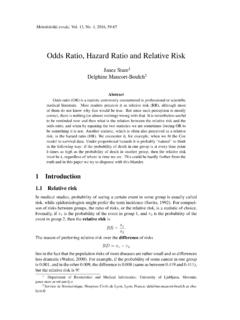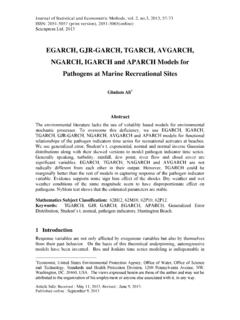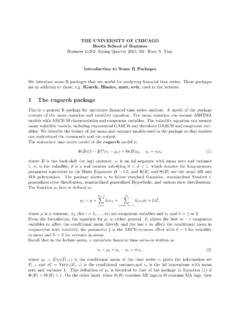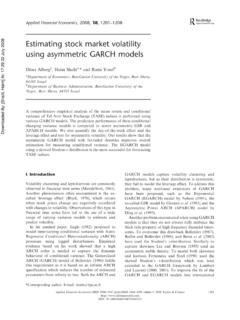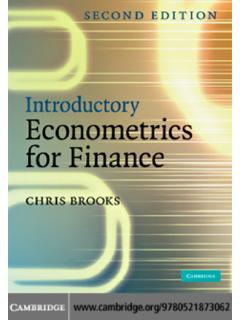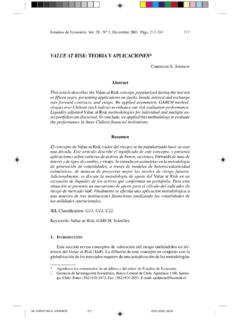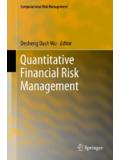Transcription of Properties and Estimation of GARCH(1,1) Model
1 Metodolo ski zvezki, Vol. 2, No. 2, 2005, 243-257 Properties and Estimation of garch (1,1) ModelPetra Posedel1 AbstractWe study in depth the Properties of the garch (1,1) Model and the assump-tions on the parameter space under which the process is stationary. In particular, weprove ergodicity and strong stationarity for the conditional variance (squared volatil-ity) of the process. We show under which conditions higher order moments of theGARCH(1,1) process exist and conclude that garch processesare investigate the sampling behavior of the quasi-maximum likelihood estimatorof the Gaussian garch (1,1) Model .
2 A bounded conditional fourth moment of therescaled variable (the ratio of the disturbance to the conditional standard deviation) issufficient for the result. Consistent Estimation and asymptotic normality are demon-strated, as well as consistent Estimation of the asymptoticcovariance IntroductionFinancial markets react nervously to political disorders,economic crises, wars or naturaldisasters. In suchstress periodsprices of financial assets tend to fluctuate very speaking, it means that the conditional variance for the given pastVar(Xt|Xt 1,Xt 2.)
3 Is not constant over time and the processXtis conditionally heteroskedastic. Econome-tricians usually say thatvolatility t= Var(Xt|Xt 1,Xt 2,..)changes over time. Understanding the nature of such time dependence is very importantfor many macroeconomic and financial applications, irreversible investments, optionpricing, asset pricing etc. Models of conditional heteroskedasticity for time series have avery important role in today s financial risk management andits attempts to make financialdecisions on the basis of the observed price asset dataPtin discrete time.
4 PricesPtarebelieved to be nonstationary so they are usually transformed in the so-calledlog returnsXt= logPt logPt returns are supposed to be stationary, at least in periods of time that are not toolong. Very often in the past it was suggested that(Xt)represents a sequence of inde-pendent identically distributed random variable, in otherwords, that log returns evolve1 Faculty of Economics, University of Zagreb, Zagreb, Croatia244 Petra Posedellike a random walk. Samuelson suggested modelling speculative prices in the continuoustime with the geometric Brownian motion.
5 Discretization ofthat Model leads to a randomwalk with independent identically distributed Gaussian increments of log return prices indiscrete time. This hypothesis was rejected in the early sixties. Empirical studies basedon the log return time series data of some US stocks showed thefollowing observations,the so-called stylized facts of financial data: serial dependence are present in the data volatility changes over time distribution of the data is heavy-tailed, asymmetric and therefore not observations clearly show that a random walk with Gaussian increments is not avery realistic Model for financial data.
6 It took some time before R. Engle found a discretemodel that described very well the previously mentioned stylized facts of financial data,but it was also relatively simple and stationary so the inference was possible. Engle calledhis modelautoregressive conditionally heteroskedastic- ARCH, because the conditionalvariance (squared volatility) is not constant over time andshows autoregressive years later, T. Bollerslev generalized the Model by introducinggeneralized au-toregressive conditionally heteroskedastic- garch Model .
7 The Properties of garch models are not easy to (1,1) processDefinition (Zn)be a sequence of random variables such thatZt N(0,1).(Xt)is called thegeneralized autoregressive conditionally heteroskedasticor garch (q,p)process ifXt= tZt, t Z( )where( t)is a nonnegative process such that 2t= 0+ 1X2t 1+..+ qX2t q+ 1 2t 1+..+ p 2t p, t Z( )and 0>0, i 0i= 1,..,q i 0i= 1,..,p.( )The conditions on parameters ensure strong positivity of the conditional variance ( ).If we write the equation ( ) in terms of thelag-operator Bwe get 2t= 0+ (B)X2t+ (B) 2t,( )where (B) = 1B+ 2B2+.
8 + qBqand (B) = 1B+ 2B2+..+ pBp.( ) Properties and Estimation of garch (1,1) Model245If the roots of the characteristic equation, 1x 2x2 .. pxp= 0lie outside the unit circle and the process(Xt)is stationary, then we can write ( ) as 2t= 01 (1)+ (B)1 (B)X2t= 0+ i=1 iX2t i( )where 0= 01 (1),and iare coefficients ofBiin the expansion of (B)[1 (B)] that the expression ( ) tells us that the garch (q,p) process is an ARCH processof infinite order with a fractional structure of the ( ) it is obvious that the garch (1,1) process is stationary if the process( 2t)is stationary.
9 So if we want to study the Properties and higher order moments ofGARCH(1,1) process it is enough to do so for the process( 2t).The following theorem gives us the main result for stochastic difference equations thatwe are going to use in order to establish the stationarity of the process( 2t).Theorem (Yt)be the stochastic process defined byYt=At+BtYt 1, t N,( )or explicitlyYt=Y0t j=1Bj+t m=1 Amt j=m+1Bj, t N.( )Suppose thatY0is independent of the sequence((At,Bt))t thatEln+|A|< and Eln|B|<0.( )Then(a)YtD Yfor some random variableYsuch that it satisfies the identity in lawY=A+BY,( )whereYand(A,B)are independent.
10 (b) Equation ( ) has a solution, unique in distribution,which is given byYD= m=1 Amm 1 j=1Bj.( )The right hand side of ( ) converges absolutely with Posedel(c) If we chooseY0D=Yas in ( ), then the process(Yt)t 0is strictly assume the moment conditionsE|A|p< andE|B|p<1 for somep [1, ).(d) ThenE|Y|p< ,and the series in ( ) converges inpth mean.(e) IfE|Y0|p< ,then(Yt)converges toYinpth mean, and in particularE|Yt|p E|Y|past .(f) The momentsEYmare uniquely determined by the equationsEYm=m k=0(mk)E(BkAm k)EYk, m= 1.]


